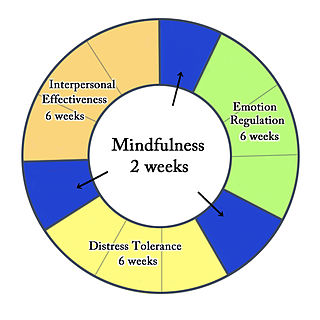Related Research Articles
Dissociative identity disorder (DID), previously known as multiple personality disorder (MPD), and colloquially known as split personality disorder, is a mental disorder characterized by the maintenance of at least two distinct and relatively enduring personality states.

Borderline personality disorder (BPD), also known as emotionally unstable personality disorder (EUPD), is a personality disorder characterized by a long-term pattern of unstable interpersonal relationships, distorted sense of self, and strong emotional reactions. Those affected often engage in self-harm and other dangerous behaviors, often due to their difficulty with returning their emotional level to a healthy or normal baseline. They may also struggle with a feeling of emptiness, fear of abandonment, and detachment from reality. Symptoms of BPD may be triggered by events considered normal to others. BPD typically begins by early adulthood and occurs across a variety of situations. Substance use disorders, depression, and eating disorders are commonly associated with BPD. Some 8 to 10% of people affected by the disorder may die by suicide. The disorder is often stigmatized in both the media and the psychiatric field and as a result is often underdiagnosed.
Narcissistic personality disorder (NPD) is a mental disorder characterized by a life-long pattern of exaggerated feelings of self-importance, an excessive need for admiration, a diminished ability to empathize with others' feelings, and (often) psychologically abusive behavior. Narcissistic personality disorder is one of the sub-types of the broader category known as personality disorders. It is often comorbid with other mental disorders and associated with significant functional impairment and psychosocial disability.

In sociology, codependency is a theory that attempts to explain imbalanced relationships where one person enables another person's self-destructive behavior such as addiction, poor mental health, immaturity, irresponsibility, or under-achievement.
Avoidant personality disorder (AvPD) is a Cluster C personality disorder characterized by excessive social anxiety and inhibition, fear of intimacy, severe feelings of inadequacy and inferiority, and an overreliance on avoidance of feared stimuli as a maladaptive coping method. Those affected typically display a pattern of extreme sensitivity to negative evaluation and rejection, a belief that one is socially inept or personally unappealing to others, and avoidance of social interaction despite a strong desire for it. It affects an approximately equal number of men and women.

Dialectical behavior therapy (DBT) is an evidence-based psychotherapy that began with efforts to treat personality disorders and interpersonal conflicts. There is evidence that DBT can be useful in treating mood disorders, suicidal ideation, and for change in behavioral patterns such as self-harm and substance use. DBT evolved into a process in which the therapist and client work with acceptance and change-oriented strategies, and ultimately balance and synthesize them, in a manner comparable to the philosophical dialectical process of thesis and antithesis, followed by synthesis.
The Minnesota Multiphasic Personality Inventory (MMPI) is a standardized psychometric test of adult personality and psychopathology. Psychologists and other mental health professionals use various versions of the MMPI to help develop treatment plans, assist with differential diagnosis, help answer legal questions, screen job candidates during the personnel selection process, or as part of a therapeutic assessment procedure.

Psychological pain, mental pain, or emotional pain is an unpleasant feeling of a psychological, non-physical origin. A pioneer in the field of suicidology, Edwin S. Shneidman, described it as "how much you hurt as a human being. It is mental suffering; mental torment." There is no shortage in the many ways psychological pain is referred to, and using a different word usually reflects an emphasis on a particular aspect of mind life. Technical terms include algopsychalia and psychalgia, but it may also be called mental pain, emotional pain, psychic pain, social pain, spiritual or soul pain, or suffering. While these clearly are not equivalent terms, one systematic comparison of theories and models of psychological pain, psychic pain, emotional pain, and suffering concluded that each describe the same profoundly unpleasant feeling. Psychological pain is widely believed to be an inescapable aspect of human existence.
Personality Assessment Inventory (PAI), developed by Leslie Morey, is a self-report 344-item personality test that assesses a respondent's personality and psychopathology. Each item is a statement about the respondent that the respondent rates with a 4-point scale. It is used in various contexts, including psychotherapy, crisis/evaluation, forensic, personnel selection, pain/medical, and child custody assessment. The test construction strategy for the PAI was primarily deductive and rational. It shows good convergent validity with other personality tests, such as the Minnesota Multiphasic Personality Inventory and the Revised NEO Personality Inventory.
The Millon Clinical Multiaxial Inventory – Fourth Edition (MCMI-IV) is the most recent edition of the Millon Clinical Multiaxial Inventory. The MCMI is a psychological assessment tool intended to provide information on personality traits and psychopathology, including specific mental disorders outlined in the DSM-5. It is intended for adults with at least a 5th grade reading level who are currently seeking mental health services. The MCMI was developed and standardized specifically on clinical populations, and the authors are very specific that it should not be used with the general population or adolescents. However, there is evidence base that shows that it may still retain validity on non-clinical populations, and so psychologists will sometimes administer the test to members of the general population, with caution. The concepts involved in the questions and their presentation make it unsuitable for those with below average intelligence or reading ability.
Lee Anna Clark is an American psychologist and William J. and Dorothy K. O’Neill Professor of Psychology in the Department of Psychology at the University of Notre Dame in Notre Dame, Indiana, United States. She used to be a professor and collegiate fellow at the University of Iowa. She was, as of 2007, the director of clinical training in the Clinical Science Program. Prior to her appointment at the University of Iowa, she was a professor of psychology at Southern Methodist University in Dallas, Texas. Her research focuses on personality and temperament, clinical and personality assessment, psychometrics, mood, anxiety, and depression.
Transference focused psychotherapy (TFP) is a highly structured, twice-weekly modified psychodynamic treatment based on Otto F. Kernberg's object relations model of borderline personality disorder. It views the individual with borderline personality organization (BPO) as holding unreconciled and contradictory internalized representations of self and significant others that are affectively charged. The defense against these contradictory internalized object relations leads to disturbed relationships with others and with self. The distorted perceptions of self, others, and associated affects are the focus of treatment as they emerge in the relationship with the therapist (transference). The treatment focuses on the integration of split off parts of self and object representations, and the consistent interpretation of these distorted perceptions is considered the mechanism of change.
Personality disorders (PD) are a class of mental disorders characterized by enduring maladaptive patterns of behavior, cognition, and inner experience, exhibited across many contexts and deviating from those accepted by the individual's culture. These patterns develop early, are inflexible, and are associated with significant distress or disability. The definitions vary by source and remain a matter of controversy. Official criteria for diagnosing personality disorders are listed in the sixth chapter of the International Classification of Diseases (ICD) and in the American Psychiatric Association's Diagnostic and Statistical Manual of Mental Disorders (DSM).
Manipulation in psychology is a behavior designed to exploit, control, or otherwise influence others to one’s advantage. Definitions for the term vary in which behavior is specifically included, influenced by both culture and whether referring to the general population or used in clinical contexts. Manipulation is generally considered a dishonest form of social influence as it is used at the expense of the others.
The mainstay of management of borderline personality disorder is various forms of psychotherapy with medications being found to be of little use.
Attention seeking behavior is to act in a way that is likely to elicit attention. Attention seeking behavior is defined in the DSM-5 as "engaging in behavior designed to attract notice and to make oneself the focus of others’ attention and admiration". This definition does not ascribe a motivation to the behavior and assumes a human actor, although the term "attention seeking" sometimes also assumes a motive of seeking validation. People are thought to engage in both positive and negative attention seeking behavior independent of the actual benefit or harm to health. Motivations for attention seeking are considered to be driven by self-consciousness and thus an externalization of personality rather than internal and self-motivated behavior. This type of influence on behavior can result in a potential loss of a person's sense of agency, personality disorder and the behavior associated with these conditions.
BPDFamily.com is an online support group for the family members of individuals with borderline personality disorder (BPD). The group is one of the first "cyber" support groups to be recognized by the medical providers and receive professional referrals.

Eric M. Plakun is an American psychiatrist, psychoanalyst, researcher and forensic psychiatrist. He is the current medical director/CEO at the Austen Riggs Center in Stockbridge, Massachusetts. Plakun's primary interests include the mental health advocacy, full implementation of the mental health parity law, access-to-care issues, and reducing health disparities; the value of and evidence base for psychosocial treatments and the diagnosis, treatment, longitudinal course and outcome of patients with borderline personality disorder and treatment resistant disorders. Plakun has been widely published and quoted in the media on psychotherapy and psychiatry, including in The New York Times and The Globe and Mail. He has appeared in the media to discuss his psychiatric work on WAMC, the Albany, New York, affiliate of NPR. and on CBS 60 Minutes. His psychiatric research has been widely cited.
Andrew E. Skodol is a professor of psychiatry at the University of Arizona and Columbia University. Skodol is a member of the American Psychiatric Association, American College of Psychiatrists, and the World Psychiatric Association. He was also the President of the Association for Research on Personality Disorders and, in 2017, the American Psychopathological Association. He graduated from Yale University and the University of Pennsylvania. Skodol received his psychiatric training at the Albert Einstein College of Medicine, where he worked as an assistant professor until 1979, when he transferred to Columbia. Becoming a professor of Clinical Psychiatry from 1995 to 2007. From 2007 to 2008 he was the president of the Institute for Mental Health Research, and from 2008 to 2011 he helmed the Sunbelt Collaborative. Skodol helped write the DSM-5 and served as the chair for its work group on personality and Personality Disorders. While writing the DSM-5 he argued for the removal of Narcissistic personality disorder. From 200 to 2003 he was the deputy director of the New York State Psychiatric Institute. He also is the chair of the Collaborative Longitudinal Personality Disorders Study. With his research primarily focused on diagnosis, stress and psychosocial functioning, Borderline personality disorder, Avoidant personality disorder, Major depressive disorder, Schizotypal personality disorder, Schizophrenia, and personality disorders. Skodol also worked to identify differing levels of severity amongst personality disorders, new personality disorder traits, new types of personality disorders, and new general personality disorder criteria.
References
- ↑ Bornovalova, Marina A., et al. "Development and validation of the Minnesota Borderline Personality Disorder scale." Assessment 18.2 (2011): 234-252.
- ↑ Rojas, Elizabeth, "Longitudinal Validation and Diagnostic Accuracy of the Minnesota Borderline Personality Disorder Scale (MBPD)". (2013). Graduate School Theses and Dissertations.